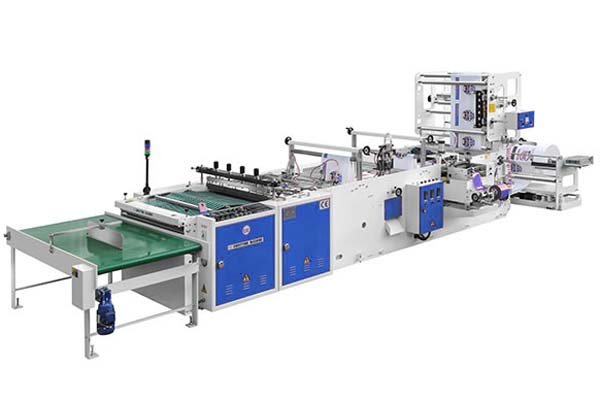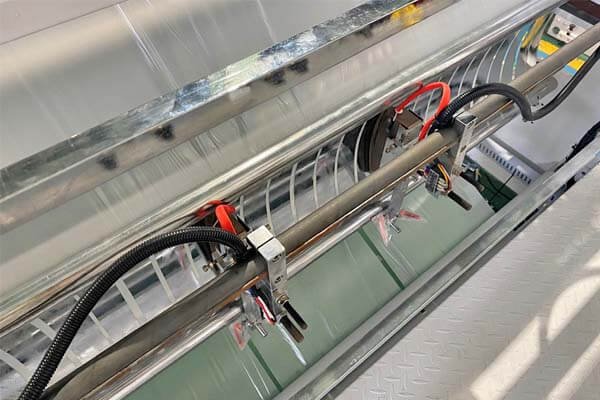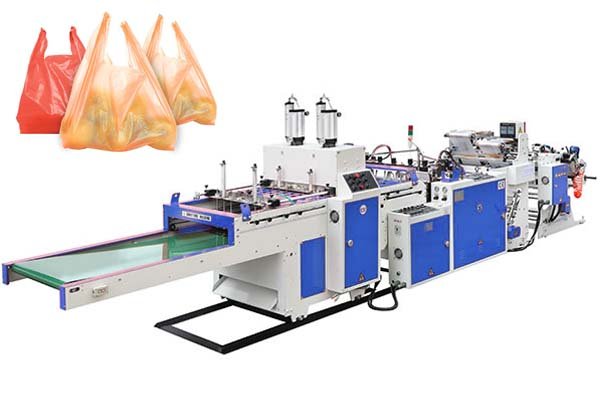
Manual handle application slows down production and reduces efficiency. Automatic handle attachment systems1 solve this by integrating directly into the bag-making process.
These systems use a separate roll of film to create handles. The film is die-cut into shape2, then bonded to the bag using ultrasonic welding3 or heat sealing4 at pre-programmed positions before the final cutting stage.
Key Stages of Operation
- Unwinding: Handle film is unwound from a dedicated roll.
- Cutting: A die-cutting unit shapes the handle loops with high precision.
- Transporting: Vacuum suction pads or a robotic arm place the handles onto the bag film.
- Bonding: The handles are sealed to the bag body using heat and pressure.
Types of Handles Supported by Automatic Systems

Automatic systems can attach various handle types, including:
Loop Handle
Used for reusable or premium retail bags. A loop of plastic is welded onto the exterior. These machines ensure a strong weld and are suitable for heavier loads.
Patch Handle
Ideal for boutique and promotional bags. A handle hole is die-cut into the bag, then reinforced from the inside with a heat-sealed patch to improve strength.
T-Shirt (Die-Cut) Handle
Common in grocery and take-out bags. A handle is punched directly into the top of the bag using a die-cutter—no separate handle material is used.
Handle Type Comparison
| Handle Type | Method | Common Use Case | Machine Model | Price Range (USD) |
|---|---|---|---|---|
| Loop Handle | Ultrasonic/Heat Welding | Reusable Retail Bags | Loop Handle Bag Machine | $33,000–$38,000 |
| Patch Handle | Internal Heat-Sealed Patch | Boutique & Promo Bags | Patch Handle Bag Machine | $8,500–$15,500 |
| T-Shirt Handle | Direct Die-Cutting | Grocery/Take-out Bags | T-Shirt Bag Machine | $17,000–$32,000 |
Production Speed of Handle Bag Machines

T-Shirt bag machines can reach speeds up to 240 bags/min. Loop handle systems typically operate at 60–120 bags/min, depending on material and size.
Key Factors Affecting Speed
- Servo Motors: High-precision servo motors5 enable faster and more stable operation while reducing power use by up to 30%.
- Material Thickness: Thicker films require longer sealing times.
- Bag Dimensions: Larger bags mean longer feeding cycles.
- Automation: Full PLC control, touchscreen settings, and auto-stacking boost uptime and consistency.
Speed Comparison Table
| Machine Type | Typical Speed (Bags/Min) | Limiting Factor |
|---|---|---|
| T-Shirt Bag Machine | 200–240 | Simple die-cutting |
| Patch Handle Machine | 80–150 | Time for sealing patch |
| Loop Handle Machine | 60–120 | Complex handle welding process |
Quality Control in Automatic Handle Attachment
![]()
Multiple QC checkpoints are built into the system: laser alignment, optical placement sensors, and weld stress tests ensure each handle is properly positioned and securely attached.
5-Stage Quality Control Process
- Material Inspection: Mechanical hardness and durability checks on machine components.
- Laser Alignment: Ensures handle placement accuracy within ±1mm.
- 72-Hour Stress Test6: Machines are run non-stop and monitored for consistency and reliability.
- Safety Testing: Emergency stops, shields, and guards are validated for CE compliance.
- Final Validation: Machine is disassembled and reassembled to confirm successful installation and functionality post-shipping.
QC Summary Table
| QC Stage | Test | Purpose | Standard |
|---|---|---|---|
| 1. Material | Component Hardness Test | Ensure Durability | ±2% |
| 2. Alignment | Laser Calibration | Accurate Handle Placement | ±1mm |
| 3. Stress Test | 72-Hour Run Test | Verify Long-Term Reliability | 99% Uptime |
| 4. Safety | CE Compliance Verification | Operator Protection | CE Certified |
| 5. Validation | Reassembly Check | Shipping & Setup Verification | Pass/Fail |
Customization Capabilities
Handle attachment systems can be customized to meet specific design or functional requirements, including special shapes, placement configurations, and added features.
Available Customizations
- Custom Die-Cut Shapes: Handles can be made in unique shapes, such as brand logos or themed designs.
- Programmable Placement: Touchscreen control allows flexible handle positioning, vertically or horizontally.
- Integrated Features: Add-ons like logo embossing or QR code printing can be included in-line.
Conclusion
Automatic handle attachment systems1 significantly improve production speed, consistency, and design flexibility. With options for customization and rigorous quality control7, modern handle bag machines are well-suited for scalable, high-volume packaging operations.
-
Explore how these systems enhance efficiency and streamline the bag-making process. ↩ ↩
-
Learn about the precision and efficiency of die-cutting in creating handles. ↩
-
Discover the advantages of ultrasonic welding for strong and reliable handle attachments. ↩
-
Find out how heat sealing improves the durability of bag handles. ↩
-
Understand the role of servo motors in enhancing operational efficiency. ↩
-
Find out how stress tests ensure long-term reliability of machinery. ↩
-
Explore effective quality control measures to ensure product reliability. ↩






